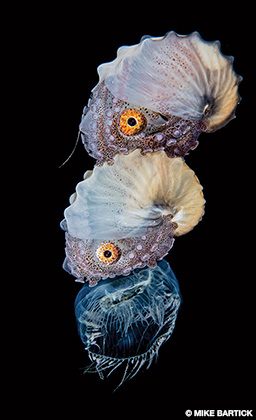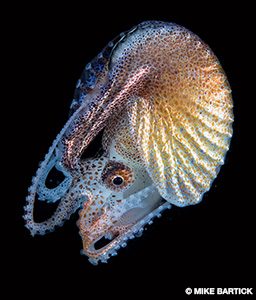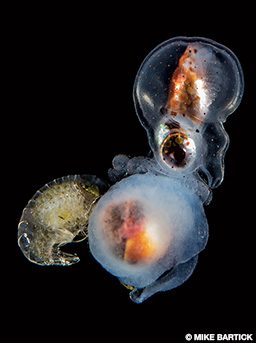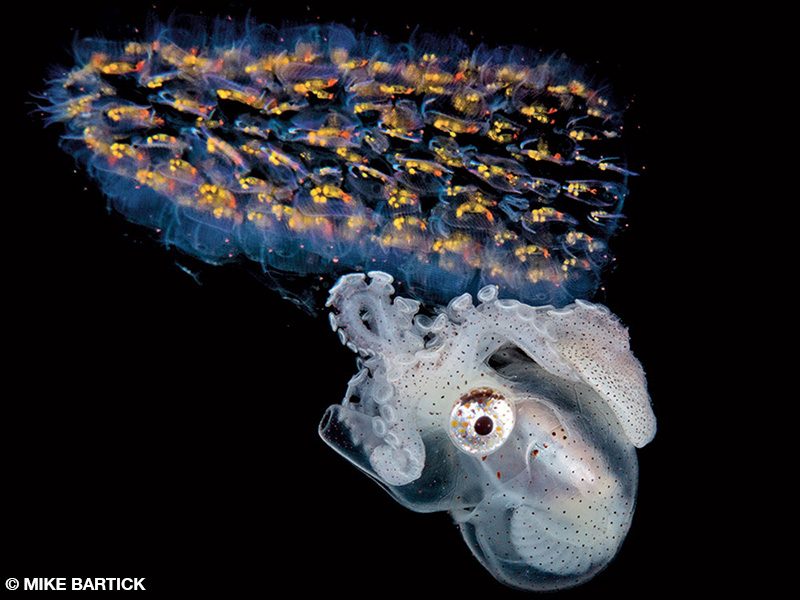One evening during a surface interval at Janao Bay, Philippines, I was talking with our boat captain, a local, generational fisherman. We speak the minimum of each other’s language, so there was usually more smiling and laughing than actual conversing. As he told me about the different areas where they used to fish over the years, he mentioned a recent fishing ban on nautiluses. At that time I knew only about the chambered nautiluses that live at extreme depths, so I was a bit surprised.

I asked for more information and learned about how they would catch the nautiluses at shallow depths. “Not deep, just there,” he said, grabbing my attention and piquing my curiosity as he pointed to the water just around our boat. Why would nautiluses come to the shallows? Perhaps I wasn’t fully understanding the conversation.
When I returned to land later that night and began searching for information, I soon realized the captain had been referring to the paper nautilus, not the chambered nautilus. Paper nautiluses (Argonauta spp.), also known as argonauts, come to the surface at night to mate and to trap air in their shells to use for buoyancy. In doing so, they expose themselves to fishermen.
Continuing my research, I noted a single sentence on the Tree of Life Web Project site (tolweb.org/Argonauta) that made me realize something about the argonauts I had overlooked: “Males have been reported living within salps.” I looked through my images and realized that I had been seeing and photographing the male paper nautilus for the past several months without even realizing it. What I had assumed were ordinary larval octopuses sheltering in the salps were actually males of a species of paper nautilus (Argonauta hians), which don’t have a shell.
The paper nautilus is a pelagic octopus in the family Argonautidae. Researchers disagree about the number of distinct extant species, but the most commonly accepted are Argonauta argo, Argonauta hians, Argonauta nodosus and Argonauta nouryi. Many known species in this family are now extinct.

Only females produce the argonaut’s paper-thin shell, a tough calcite compound that they secrete from their two dorsal tentacles and use as an eggcase for brooding. Nautiluses can quickly jet-propel themselves through the water, making it difficult to photograph them — like trying to photograph a butterfly while running down the street.
The photogenic females have huge, well-developed eyes; they look like beardless gnomes with their bodies tucked into their hatlike shells. Full-grown females typically measure about 4 inches, while mature males are less than 1/4 inch. While a size difference between genders (sexual dimorphism) is common in nature, the drastic disparity between male and female argonauts is unusual.
A drop in the water temperature each year ushers in the argonaut mating season. As the water cools, divers can see the number of male argonauts in the water column dramatically increase from one or two to 20 or more on a single dive. In the black of night, the males buzz around like swarms of tiny bumblebees as they search for a mate.

Sexually mature females tend to be a bit shy during the off season, when the number of sightings are minimal. In contrast, mating season happens quickly, going from a single sighting one night to multiple sightings the next as the females begin to form groups. When the beams from our dive lights pass through a group of females, they instantly scatter and shoot toward us like kamikazes, running into our cameras and heads, bouncing off and rocketing toward the surface.
Both males and females ride jellyfish, salps and other objects such as leaves, sticks and even drifting debris. Researchers have found bits of jellyfish and salp in the stomachs of nautiluses, indicating that these cephalopods can survive in the water column by feeding on plankton and other mollusks or near substrate by feeding on shrimp and crabs. Like other species of octopus, argonauts possess a venom that is passed through their saliva when they use their beaks to kill their prey.
For the best chance to see a nautilus in the wild, be in the water at night in an area where they are usually found. It might require multiple dives at different times of the year — and a little bit of luck — to see one.
Capturing the Shot
When photographing argonauts, I prefer to use a 60mm lens, ISO 400, 1/200 shutter speed and the aperture at f/18. I set my strobes at half power and position them close to the lens port.
When framing the image, watch the argonauts’ eyes for sharp contact, and be prepared to swim quickly. Argonauts are light sensitive — using a red light can help calm them down, although it is not always necessary. Using a handheld light with a tight beam can help you see through turbid water. Refrain from touching the animals; they stress easily and like most cephalopods will ink profusely.

The argonaut is now a highly valued species for blackwater divers. Given the number of paper nautiluses we have seen in such a short time, the once-rare and unique subject has become more common.
Although sightings of paper nautiluses are on the rise, they are still one of nature’s biggest mysteries and have gone mostly unnoticed for a long time. Argonauts are a fascinating spectacle and will likely leave you as they have left me: in awe of nature.
© Alert Diver — Q3 Summer 2019